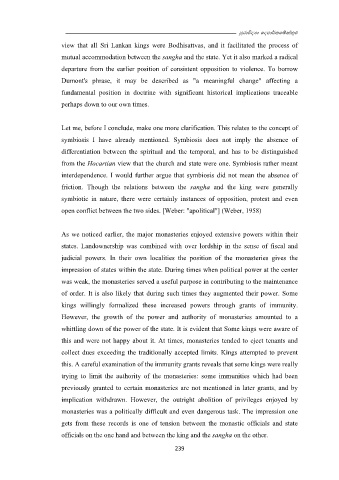Page 260 - Proceedings book
P. 260
mqrdúoHd fomd¾;fïka;=j
view that all Sri Lankan kings were Bodhisattvas, and it facilitated the process of
mutual accommodation between the sangha and the state. Yet it also marked a radical
departure from the earlier position of consistent opposition to violence. To borrow
Dumont's phrase, it may be described as "a meaningful change" affecting a
fundamental position in doctrine with significant historical implications traceable
perhaps down to our own times.
Let me, before I conclude, make one more clarification. This relates to the concept of
symbiosis I have already mentioned. Symbiosis does not imply the absence of
differentiation between the spiritual and the temporal, and has to be distinguished
from the Hocartian view that the church and state were one. Symbiosis rather meant
interdependence. I would further argue that symbiosis did not mean the absence of
friction. Though the relations between the sangha and the king were generally
symbiotic in nature, there were certainly instances of opposition, protest and even
open conflict between the two sides. [Weber: "apolitical"] (Weber, 1958)
As we noticed earlier, the major monasteries enjoyed extensive powers within their
states. Landownership was combined with over lordship in the sense of fiscal and
judicial powers. In their own localities the position of the monasteries gives the
impression of states within the state. During times when political power at the center
was weak, the monasteries served a useful purpose in contributing to the maintenance
of order. It is also likely that during such times they augmented their power. Some
kings willingly formalized these increased powers through grants of immunity.
However, the growth of the power and authority of monasteries amounted to a
whittling down of the power of the state. It is evident that Some kings were aware of
this and were not happy about it. At times, monasteries tended to eject tenants and
collect dues exceeding the traditionally accepted limits. Kings attempted to prevent
this. A careful examination of the immunity grants reveals that some kings were really
trying to limit the authority of the monasteries: some immunities which had been
previously granted to certain monasteries are not mentioned in later grants, and by
implication withdrawn. However, the outright abolition of privileges enjoyed by
monasteries was a politically difficult and even dangerous task. The impression one
gets from these records is one of tension between the monastic officials and state
officials on the one hand and between the king and the sangha on the other.
239

